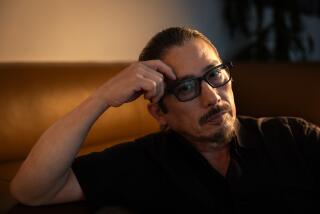Oida Lets Body Language Do the Talking : Stage: The Peter Brook disciple explores the self in a new theater work based on movement.
If you want to communicate in the global, technological, multicultural world of the ‘90s, says actor Yoshi Oida, try getting fluent in the language of the body.
“Speech is the lowest form of communication in theater and life,” argues this Paris-based, Japanese-born Peter Brook disciple whose irrepressible giggle and physical energy make him seem a generation younger than his 57 years.
“Language doesn’t show the invisible relations that exist between people, especially people who don’t speak the same verbal language,” he adds. “The body reveals more.”
That’s an odd philosophy for an actor to have, but Oida’s no ordinary performer.
For 10 years, Oida studied to become a Zen Buddhist priest in the esoteric Shingon sect in Japan before joining Peter Brook’s International Theater Research Center in Paris in 1968. He says he never intended to become a priest, “but once was a very unhappy man” and wanted “to use the ‘research’ for self-exploration.”
These very examinations form the thematic backbone of his “Interrogations,” a movement-based theater work he is performing though Saturday at the downtown Patriotic Hall. Dieter Trustedt provides original live music.
Oida also is giving intensive acting workshops in which teaches local performers to develop “interior energy” through body and voice work. Another workshop will start Thursday. It’s this encounter between East and West and mind and body that Oida says he encourages in workshops and performances--”to find the meeting place between the internal energy of the audience and the actor’s.”
Oida was last seen in Los Angeles when Brook brought his marathon theatrical adaptation of India’s religious epic, “The Mahabharata,” to the 1987 Los Angeles Festival. Oida, who acknowledges that his English is hard to understand, played the role of Drona, an evil prince, by emphasizing the vicious physicality of the master swordsman.
He recalls feeling more communicative “grunting and moving” on stage than speaking translator Jean-Claude Carriere’s words, a phenomenon that finally confirmed what this storyteller says he spent his life learning.
“If you want to play a character well, you must spend a long time making it live in your body.”
“When theater stops becoming a spiritual space for actors, it stops living,” he says, adding that the rigor of performing a single role in Brook’s “Mahabharata” for three years “drove him crazy.”
“I began hating the lines,” he adds.
“Sometimes the real sources for metaphysical expression can be found in simple places, like in the limbs, fingertips and toes.”
Then why not call “Interrogations” a dance?
“I was trained in classical Japanese Noh Theater, and taught that to have a total theatrical experience you had to integrate movement, song and storytelling,” the actor and martial-arts expert explains. “I’ve carried that desire for tapestry (of forms) my whole life. Besides, words can give you shortcuts to ideas.”
It’s such “shortcuts” that have made “Interrogations” so popular during the 20 years that Oida has performed the part-circusy, part-religious work. Oida punctates his movements--semaphores, circle-walks, sitting movements--with verbal Zen koans or philosophic questions, asked to the audience.
“Is it the audience who comes to the theater,” he asks, “or the theater that comes to the audience?”
“The questions are simple and the movement is minimal,” he says. “I believe that the less that goes on, the better.”
“I’m not really interested in performing,” he says, smiling. “I’m interested in how I have developed today. How dare I say I am an ‘actor’ or a ‘dancer’ when my real role is to be a human. Theater is simply a mask for how we might live our myths.”
Oida makes his point by executing a wavy, cradle gesture that ends mysteriously with a finger pointing to the sky.
“This is a moon dance,” he whispers. “But you shouldn’t feel it as a dance, but the moon itself.
“When I teach the movement to students, I point to the fingertip at the end of the gesture, because that’s where the dance really begins. You have to find the path from the finger to the moon yourself. That can’t be taught in words. That, you see, is a way of life.”
More to Read
The biggest entertainment stories
Get our big stories about Hollywood, film, television, music, arts, culture and more right in your inbox as soon as they publish.
You may occasionally receive promotional content from the Los Angeles Times.










